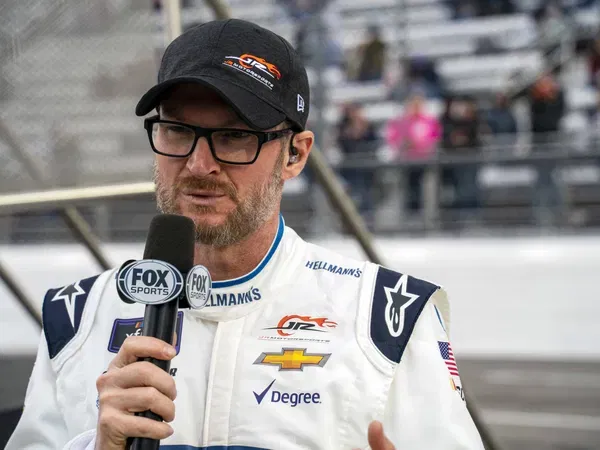

If there’s one thing that can stir up a garage full of NASCAR veterans faster than a late-race caution, it’s the H word: horsepower. And it’s been shifting gears for decades. From the 350–600 HP range during the “Aero Wars” of the 1950s–70s to the peak 850 HP era, NASCAR has long wrestled with the balance between speed and control. But today, it’s not the cars but the drivers sounding the alarm.
Watch What’s Trending Now!
Denny Hamlin dubbed the current limits an “illusion,” Joey Logano has dismissed minor tweaks, and Michael McDowell went so far as to call the high horsepower an illusion, or rather go for an “impossible” 200-HP boost. Now the conversation has reached the rulemakers, and for the first time in a while, officials are finally addressing the elephant under the hood.
Yes, NASCAR’s VP of Competition, Elton Sawyer, has hinted at possible round table talks, saying, “It’s on the table.” But Dale Earnhardt Jr. agrees with Michael McDowell. Not calling it an “illusion,” but the veteran racer’s got some real analysis.
ADVERTISEMENT
Dale Earnhardt Jr. emphasizes that the issue isn’t necessarily how much horsepower the cars have, but rather how that power interacts with other car dynamics. “I think that Michael McDowell is correct in that the pro horsepower isn’t what’s wrong with this race car, and this is a very small change, and it might visually look exactly the same as what we see today in terms if we just go to Martinsville and do this. I know there are a couple of other short tracks,” Junior added.
According to him, increasing horsepower could make the car tougher on the tires, and he states Martinsville as an example. Now, Martinsville is a 0.5-mile track with Asphalt on straights and higher lanes of turns, and concrete on lower lanes of turns. For those who don’t know, this type of surface is abrasive and tough on brakes and tires.
Ideally, for such tracks, low horsepower = less tire wear and braking challenge, hence more safety and a better race for drivers. So, adding more HP would force drivers to manage their equipment more carefully.
ADVERTISEMENT
Junior is concerned for the drivers. He goes on to say, “It may not—it may be very marginal what this does, but here’s what horsepower I know can do, all right. It’ll be a little tougher on the tires, and there’s a hope that that would make things a little more difficult for the drivers.”
In other words, when drivers have to work harder on tire management and braking, it opens up the possibility for more side-by-side action and exciting passes. So, this could equally benefit the sport. Knowing that NASCAR has made some serious changes for the sport’s sake, like moving to Prime to attract a younger audience, adding more horsepower is quite a possibility. But that horsepower affects tires, typically allowing all four tires to change in every pit stop, and could result in dangerous shifts.
ADVERTISEMENT
Remember the 2025 Kansas Speedway Practice where five teams encountered flat rear tires? While many would call it aggression. The real reason was stated by NASCAR Cup Series managing director Brad Moran. “Everybody is looking if there’s any speed, pushing the limits, which can create tire wear,” Moran added, pointing at multiple aspects. In practice, 5 Cup teams were snagged by the tire wear, nearly crashing and damaging their cars. So, maybe Junior’s got a point.
Adding to Moran’s analysis, Goodyear product manager Rick Heinrich had also shared some crucial insights. “Everybody is getting as aggressive as they can be with those rear air pressures, trying to get that back end down. Speeds are up a bit, which is going to increase loads. In a situation like this, where you start out with air pressure that low, the damage is done immediately. When you cross that line on air pressure, the damage is going to happen pretty quick.”
Despite these warnings, drivers and NASCAR are going on with the change, and let’s hope it benefits everyone.
ADVERTISEMENT
Elliot is also open to more power. Here’s his reason
Among those weighing in is NASCAR’s most popular driver, Chase Elliott. Though the 2020 Cup champion isn’t one to jump on a soapbox like Denny Hamlin or Bubba Wallace, even the cool-headed Hendrick champ can’t ignore the chatter in the garage. He is cautiously optimistic about cranking things up to 750 hp—but only if the engine folks are on board.
Speaking at a national super Speedway media session, Elliott admitted, ” I’m not super in-tune with what those numbers are or like what’s being talked about as far, as how far they want to go with it. So, I don’t know that I’m super educated on kind of what’s possible, what’s even true or not true. I think it’d be worth a shot, you know, if the engine manufacturers are willing to do it.”
ADVERTISEMENT
And that’s the kicker: the manufacturers hold the keys to the kingdom. NASCAR can talk about going full throttle all it wants, but unless the engine builders say so, it’s just shop talk. The No. 9 driver says, ” And that’s probably going to be a question for them, truthfully, because they’re going to dictate how much power we can give the current packages that we have and still have the longevity and the reliability we expect to have because I think we have to run them three times.”
In other words, sure, drivers want more horsepower under the hood, but not if they throw a piston halfway through a three-race engine cycle. It’s a tug of war between performance and durability, and NASCAR has to figure out how to thread the needle if it wants the racing to get rowdy again.
ADVERTISEMENT
ADVERTISEMENT
ADVERTISEMENT

